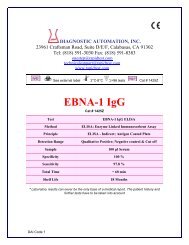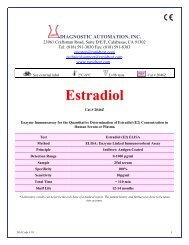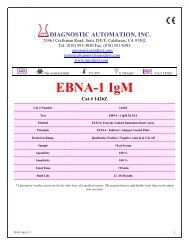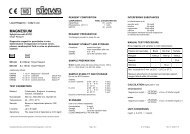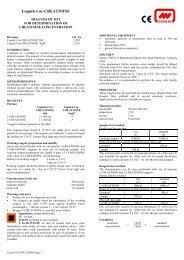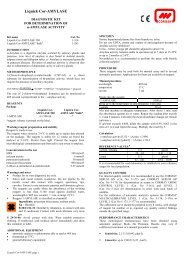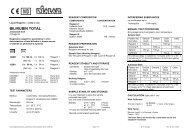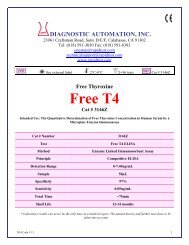Cytomegalovirus IgM (CMV IgM)
Cytomegalovirus IgM (CMV IgM)
Cytomegalovirus IgM (CMV IgM)
You also want an ePaper? Increase the reach of your titles
YUMPU automatically turns print PDFs into web optimized ePapers that Google loves.
DIAGNOSTIC AUTOMATION, INC.23961 Craftsman Road, Suite D/E/F, Calabasas, CA 91302Tel: (818) 591-3030 Fax: (818) 591-8383onestep@rapidtest.comtechnicalsupport@rapidtest.comwww.rapidtest.comSee external label 2°C-8°C Σ=96 tests Cat # 1202Z<strong>Cytomegalovirus</strong> <strong>CMV</strong> <strong>IgM</strong>Cat # 1202ZTestMethodPrincipleDetection RangeSample<strong>CMV</strong> <strong>IgM</strong> ELISAELISA: Enzyme Linked Immunosorbent AssayELISA - Indirect; Antigen Coated PlateQualitative Positive; Negative control & Cut off5ul SerumSpecificity 97%Sensitivity 98 %Total TimeShelf Life~90 min12 -18 Months* Laboratory results can never be the only base of a medical report. The patient history and further tests have to be taken intoaccountDAI Code # 11 1
NAME AND INTENDED USEThe DIAGNOSTIC AUTOMATION ELISA, <strong>CMV</strong> <strong>IgM</strong> is intended for use in the detection of <strong>IgM</strong> antibodies to<strong>Cytomegalovirus</strong> (<strong>CMV</strong>) infection.SUMMARY AND EXPLANATION OF THE TEST<strong>Cytomegalovirus</strong> is a herpes virus and a leading biological factor causing congenital abnormalities andcomplications among those who receive massive blood transfusions and immunosuppressive therapy. Abouthalf of pregnant women who contract a primary infection spread the disease to their fetus. When acquired inutero,the infection may cause mental retardation, blindness, and/or deafness.Serological tests for detecting the presence of antibody to <strong>CMV</strong> can provide valuable information regarding thehistory of previous infection, diagnosis of active or recent infection, as well as in screening blood fortransfusions in newborns and immuno-compromised recipients. DIAGNOSTIC AUTOMATION ELISA <strong>CMV</strong><strong>IgM</strong> is an accurate serologic method to detect <strong>CMV</strong> <strong>IgM</strong> antibody for identification of <strong>CMV</strong> infection.PRINCIPLE OF THE TESTPurified <strong>CMV</strong> antigen is coated on the surface of microwells. Diluted patient serum is added to wells, and the<strong>CMV</strong> <strong>IgM</strong> specific antibody, if present, binds to the antigen. All unbound materials are washed away. Afteradding enzyme conjugate, it binds to the antibody-antigen complex. Excess enzyme conjugate is washed offand TMB Chromogenic Substrate is added. The enzyme conjugate catalytic reaction is stopped at a specifictime. The intensity of the color generated is proportional to the amount of <strong>IgM</strong> specific antibody in the sample.The results are read by a microwell reader compared in a parallel manner with calibrator and controls.MATERIALS PROVIDED1. Microwell Strips: purified <strong>CMV</strong> antigen coated wells (12X8 wells)2. Absorbent Solution: Black Cap 1 vial (22 mL)3. Calibrator: Factor value (f) stated on label. Red Cap 1 vial (150µL)4. Negative control. Range Stated on label. Natural Cap 1 vial (150µL)5. Positive control. Range stated on label. Green Cap 1 vial (150µL)6. Washing Concentrate 10X: White Cap 1 Bottle (100 mL)7. Enzyme Conjugate: Red color solution 1 vial (12 mL)8. TMB Chromogenic Substrate: Amber bottle 1 vial (12mL)9. Stop Solution 1 vial (12 mL)STORAGE AND STABILITY1. Store the kit at 2 - 8 ° C.2. Always keep micro wells tightly sealed in pouch with desiccants. We recommend you use up all wellswithin 4 weeks after initial opening of the pouch.3. The reagents are stable until expiration of the kit.4. Do not expose test reagents to heat, sun or strong light during storage or usage.WARNINGS AND PRECAUTIONS1. Potential biohazardous materials: The calibrator and controls contain human source components whichhave been tested and found non-reactive for hepatitis B surface antigen as well as HIV antibody withFDA licensed reagents. However, as there is no test method that can offer complete assurance thatHIV, Hepatitis B virus or other infectious agents are absent, these reagents should be handled at theDAI Code # 11 2
Biosafety Level 2, as recommended in the Centers for Disease Control/National Institutes of Healthmanual, "Biosafety in Microbiological and Biomedical Laboratories." 1984.2. Do not pipette by mouth. Do not smoke, eat, or drink in the areas in which specimens or kit reagentsare handled.3. The components in this kit are intended for use as a integral unit. The components of different lotsshould not be mixed.4. This product contains components preserved with sodium azide. Sodium azide may react with leadand copper plumbing to form explosive metal azide. On disposal, flush with a large volume of water.SPECIMEN COLLECTION AND HANDLING1. Collect blood specimens and separate the serum.2. Specimens may be refrigerated at 2 - 8 º C for up to seven days or frozen for up to six months. Avoidrepetitive freezing and thawing of serum sample.PREPARATION FOR ASSAY1. Prepare 1x washing buffer. Prepare washing buffer by adding distilled or deionized water to 10 x washconcentrate to a final volume of 1 liter.2. Bring all specimens and kit reagents to room temperature (20-25 °C) and gently mix.ASSAY PROCEDURE1. Place the desired number of coated strips into the holder.2. Prepare 1:40 dilutions by adding 5 µl of the test samples, negative control, positive control, andcalibrator to 200 µl of absorbent solution. Mix well.3. Dispense 100 µl of diluted sera, calibrator, and controls into the appropriate wells. For the reagentblank, dispense 100 µl absorbent solutions in 1A well position. Tap the holder to remove air bubblesfrom the liquid and mix well. Incubate for 30 minutes at room temperature.4. Remove liquid from all wells. Repeat washing three times with washing buffer.5. Dispense 100 µl of enzyme conjugate to each well and incubate for 30 minutes at room temperature.6. Remove enzyme conjugate from all wells. Repeat washing three times with washing buffer.7. Dispense 100 µl of TMB Chromogenic Substrate to each well and incubate for 30 minutes at roomtemperature.8. Add 100 µl of 2 N HCl to stop reaction. Make sure there are no air bubbles in each well before reading9. Read O.D. at 450 nm with a Microwell reader.CALCULATION OF RESULTS1. To obtain cut off OD value: Multiply the OD of Calibrator by Factor (f) printed on label of calibrator.2. Calculate the <strong>CMV</strong> <strong>IgM</strong> Index of each determination by dividing the OD value of each sample byobtained OD value of cut off.For example:If the factor (f) value on label = 0.4Obtained Calibrator O.D. = 1.100Cut-off O.D. = 1.100 X 0.4 = 0.44Patient sample O.D. = 0.580<strong>CMV</strong> <strong>IgM</strong> Index = 0.580 / 0.44 = 1.32 (Positive Result)Patient sample O.D = 0.320<strong>CMV</strong> <strong>IgM</strong> Index = 0.320 / 0.44 = 0.73 (Negative Result)DAI Code # 11 3
QUALITY CONTROLThe test run may be considered valid provided the following criteria are met:1. The O.D. value of the reagent blank against air from a microwell reader should be less than 0.250.2. If the O.D. value of the Calibrator is lower than 0.250, the test is not valid and must be repeated.3. The <strong>CMV</strong> M Index for Negative and Positive Control should be in the range stated on the labels.INTERPRETATIONNegative: <strong>CMV</strong> M Index of less than 0.90 are negative for <strong>IgM</strong> antibody to <strong>CMV</strong>.Equivocal:Positive:<strong>CMV</strong> M Index between 0.91 - 0.99 is equivocal. Sample should be retested.<strong>CMV</strong> M Index of 1.0 or greater are positive for <strong>IgM</strong> antibody to <strong>CMV</strong>.PERFORMANCE CHARACTERISTICSPrecision:The precision of the assay was evaluated by testing three different sera of eight replicates over 3 days. Theintra-assay and inter-assay C.V. are summarized below:Negative Low positive PositiveIntra-assay 7.8% 6.0% 5.8%Inter-assay 8.9% 7.4% 6.2%LIMITATIONS OF THE TEST1. To prevent false negative and false positive <strong>IgM</strong> test results caused by the presence of specific IgG andrheumatoid factor (RF) in some specimens, reagents provided in this kit has been formulated to resolvethese interferences. However, specimens with extremely high RF and high autoimmune antibodies, thepossibility of these interferences cannot be ruled out entirely.2. As with other serological tests, the results obtained with the <strong>CMV</strong> <strong>IgM</strong> ELISA serve only as an aid todiagnosis and should be interpreted in relation to other clinical and diagnostic findings.3. <strong>IgM</strong> responses may vary in different individuals. It has been reported that 10-30 % of infants may failto develop <strong>IgM</strong> antibody responses despite congenital <strong>CMV</strong> infection. Furthermore, up to 27 % ofadults with primary <strong>CMV</strong> infection may not demonstrate an <strong>IgM</strong> response. Thus, the absence of <strong>CMV</strong>specific<strong>IgM</strong> does not necessarily exclude the possibility of <strong>CMV</strong> infection.4. The presence or absence of <strong>CMV</strong> IgG or <strong>IgM</strong> in pregnant women is of limited value in predictingcongenital <strong>CMV</strong> infection. However, the presence of specific <strong>IgM</strong> in the circulation of the newborn isindicative of infection. Since serum samples obtained too early in infection may not contain detectable<strong>IgM</strong> antibody, a subsequent sample should be obtained 7 to 14 days later and test. In the case ofcord blood, care should be taken to avoid contamination by maternal blood, and it is prudent toconfirm positive <strong>IgM</strong> antibody results by testing a follow-up specimen from the newborn.REFERENCES1. Voler, A., J.E. Bidwell, et al. Manual of clinical immunology. Chapter 69. Rose, N. and Friedman, H.eds. Am. Soc. Microbiol. p.506, 1985.DAI Code # 11 4
2. Cremer, N.E. Antibodies in serodiagnosis of viral infection. p. 73. In Lennett E.H. ed. Laboratorydiagnosis of viral infection. Mercel Dekker, Inc., New York, 1985.3. Starr, S.E. and H.M. Friedman. "Human <strong>CMV</strong>." Chapter 65. In Manual of Clin. Microbiol., 4th ed.,Lennett, E.H. et al ed. Am. Soc. Microbiol. pp. 771-719, 1985.Date Adopted Reference No.2010-10-04 DA-<strong>CMV</strong> <strong>IgM</strong>-2010DIAGNOSTIC AUTOMATION, INC.23961 Craftsman Road, Suite D/E/F, Calabasas, CA 91302Tel: (818) 591-3030 Fax: (818) 591-8383ISO 13485-2003Revision Date: 11-03-2010DAI Code # 11 5






